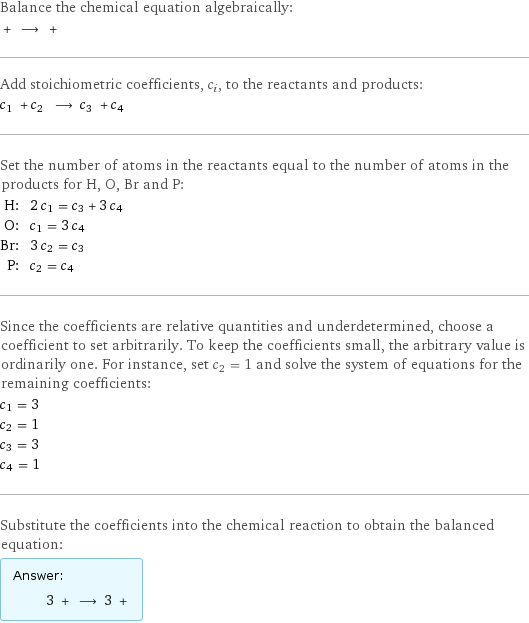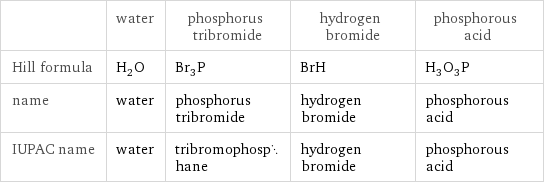Input interpretation

water + phosphorus tribromide ⟶ hydrogen bromide + phosphorous acid
Balanced equation

Balance the chemical equation algebraically: + ⟶ + Add stoichiometric coefficients, c_i, to the reactants and products: c_1 + c_2 ⟶ c_3 + c_4 Set the number of atoms in the reactants equal to the number of atoms in the products for H, O, Br and P: H: | 2 c_1 = c_3 + 3 c_4 O: | c_1 = 3 c_4 Br: | 3 c_2 = c_3 P: | c_2 = c_4 Since the coefficients are relative quantities and underdetermined, choose a coefficient to set arbitrarily. To keep the coefficients small, the arbitrary value is ordinarily one. For instance, set c_2 = 1 and solve the system of equations for the remaining coefficients: c_1 = 3 c_2 = 1 c_3 = 3 c_4 = 1 Substitute the coefficients into the chemical reaction to obtain the balanced equation: Answer: | | 3 + ⟶ 3 +
Structures

+ ⟶ +
Names

water + phosphorus tribromide ⟶ hydrogen bromide + phosphorous acid
Chemical names and formulas

| water | phosphorus tribromide | hydrogen bromide | phosphorous acid Hill formula | H_2O | Br_3P | BrH | H_3O_3P name | water | phosphorus tribromide | hydrogen bromide | phosphorous acid IUPAC name | water | tribromophosphane | hydrogen bromide | phosphorous acid
Substance properties

| water | phosphorus tribromide | hydrogen bromide | phosphorous acid molar mass | 18.015 g/mol | 270.69 g/mol | 80.912 g/mol | 81.995 g/mol phase | liquid (at STP) | liquid (at STP) | gas (at STP) | solid (at STP) melting point | 0 °C | -41.5 °C | -86.8 °C | 74 °C boiling point | 99.9839 °C | 175 °C | -66.38 °C | density | 1 g/cm^3 | 2.88 g/cm^3 | 0.003307 g/cm^3 (at 25 °C) | 1.597 g/cm^3 solubility in water | | reacts | miscible | surface tension | 0.0728 N/m | 0.0458 N/m | 0.0271 N/m | dynamic viscosity | 8.9×10^-4 Pa s (at 25 °C) | 0.001302 Pa s (at 60 °C) | 8.4×10^-4 Pa s (at -75 °C) | odor | odorless | | |
Units
